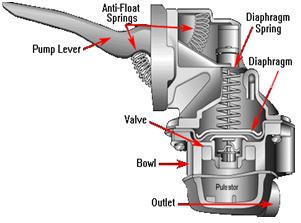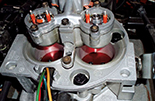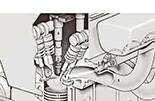Fuel & fuel pumps
As noted in the induction section, originally the relied on gravity, or the weight of the fuel to get it from the tank to the carburetor. While it does work there are many, many inherent problems with this and once you begin to chase a little bit of power it just will not work. So was born the mechanical pump and for the most part they were all that were used till gasoline fuel injection arrived.

These work great and are very reliable but..., ah yes the but... chasing more power and doing things the engineers had not planned on, we discover that we need more fuel, both in volume and in pressure and designing mechanical pumps to deliver that and fit in the original position gets a little expensive and then we run into two other issues. Chasing more horsepower we usually increase the engine's rpm and at some point we began to run into issues with the design of the mechanical pump, it can not physically keep up and there is one more thing, driving that pump takes power, not much, but some and that is power that is not making it to the wheels. Using an electric pump, since we are already loosing a predetermined amount of horsepower to our electrical system, allows us to deliver fuel without loosing the power lost to the mechanical pump.
With the advent of fuel injection to the gasoline engine, electric pumps were a must. In the beginning it was a mechanical injection system and a low pressure, high volume electric pump was used to lift the fuel up to the high pressure injection pump, some manufacturers used a low pressure mechanical pump but most went electric. As we progressed from mechanical fuel injection to electronic injection (most being some sort of throttle body or port injection, even though direct gasoline fuel injection has been around for a fairly long time many inherent problems just could not be overcome until recently and even then we still have issues with carbon build up and ignition failures) and fuel pump pressures went form a few pounds per square inch, used in carbureted systems to, 30, 40 and as high as 95 pounds per square inch. Some of today's direct injected engines can reach pressures as high as 2900 pounds per square inch, but to achieve that they have taken a page from the past and use a low pressure high volume pump to deliver fuel to a very high pressure mechanical injection pump that delivers fuel to computer controlled injectors





Fuel Tech
Let's talk about fuel. For a subject that is very scientific I hear more black magic than facts.First some real simple facts then for those of you who care to read on a little deeper look and for those who want more click on the link at the end of the article.
Fuels of today do not last very long. According to the fuel manufactures the fuel is good for about 3 months. I believe in our older cars 2 is closer to the mark. One noticeable exception is Sunoco's 100 octane unleaded race fuel that they sell at the pumps at select gas stations. The company claims a year and we have to agree with them. So if you park your car either fill it up with 100 octane fuel or go to the local marine store and put some stable in the fuel. Follow the directions on the bottle. Or you can have your fuel system overhauled every year.
What most of us with older cars worry about is Octane and Lead. Let's start with octane first. Since as early as 1912 engineers have known that the limiting factor in compression was engine knock. They just did not know what knock was. Most people still do not. It is not pre-ignition, though that can cause knock and knock can cause pre-ignition. Knock is actually post-ignition! Without getting to technical it has to do with flame fronts in unburnt fuels and gasses and how rapid the fuel is burnt in your combustion cycle. Pre-ignition is usually caused by deposits & overheating.
Somewhere in the mid 1920's they figured out that knock was not caused by those new electric starters or by battery powered ignition systems. And from then to now they have been refining the way they measure a fuels properties and it almost all comes down to controlling knock. If your engine knocks your are going to self detonate it. So as we clean up the fuels and cut down the emissions keeping knock under control is still the biggest factor.
In very simple terms the higher the octane the slower the fuel burns and the more complete the burn. If I am burning slower I am also burning cooler which can allow me to do things like increase timing and run higher coolant temperatures, all of which give me more power. So, why don't we just have nothing but higher octane fuels? Cost and waste are two huge reasons. To produce higher octane fuels with out a lot of additives takes more refining, higher costs, and you get less fuel per each barrel of oil, costs and waste. Lead was a great additive for the fuel companies. it was cheap and did the job. It cooled the combustion chamber and did the same as higher octane fuels for a whole lot less money. Unfortunately it has a couple of major drawbacks. First it builds up in the engines and on valves. Read your old repair manuals and removing heads for cleaning was normal routine service. Cutting ridges out of the top of cylinders to get the piston out was an everyday process. Second it is very bad for every one and every thing. Air borne lead was a major cause of poor test scores and learning disabilities in children. Contact with it was a quick way to a slow death. So getting rid of it is a good thing. But wait, what about lubrication properties? Being clean is much better than the little bit of lube you got from your lead. Oh by the way Jaguar starting putting hardened seats in their heads in 1948, Almost every car has hardened seats after 1974 when they first started mandating lower lead fuels. When catalytic converters showed up in 1978 they all have them as lead disappeared from the fuels at the same time! For those of you with older and especially pre-war cars the use of no-lead fuels will slightly speed up your head's demise but most of the failure is poor metals and age! When you have it re-done you will have a lead free engine unless your machine shop is incompetent or dishonest.
Now here is something people with older cars may find hard to believe but it is true. Because the fuels are so much cleaner and the additives so much better today that it is not unusual for an older car to run on lower octane today than it did new! If you find you are fouling you plugs on high octane back up one grade and see what happens. To get an idea of what octane to use for what engine here is a little chart, now remember engine design, driving habits, engine state all effect the octane requirements. And yes you may find you have no ping on one company's fuel and do on another of the same rating. how and what the additive package is makes a huge difference.
| compression ratio | octane | brake thermal efficiency |
| 5:1 | 72 | - |
| 6:1 | 81 | - |
| 7:1 | 87 | 25% |
| 8:1 | 92 | 28% |
| 9:1 | 96 | 30% |
| 10.1 | 100 | 32% |
| 11:1 | 104 | 33% |
| 12:1 | 108 | 34% |
This chart is for normally aspirated pre-fuel management cars. Interesting to see how much energy your engine wastes!
A brand new engine can run on octane about 6-9 points lower for the first 12,000 miles or so an oil burner may need as much as 12 points higher!
The cooler the temps the lower the octane requirements. So you should be able to reduce the octane requirements for your car in the winter. Very high humidity reduces octane requirements too. The higher the altitude and the numbers go down too. Makes sense as there is less oxygen up there. Av gas has a much lower boiling point than car fuels, it is much colder up there, so using av gas to boost octane can cause vapor locks in the right conditions.
The higher the rpms of your engine the less knock is a factor as there is less time for pre-flame reactions in the end gasses. The cause of knock.
| timing and knock | ||
| Octane Requirements: | ||
| retard 5 degrees | Stock | advance 5 degrees |
| 88 | 91 | 93 |
| 86 | 90.5 | 94.5 |
| 85.5 | 88 | 92.5 |
| 84 | 87.5 | 91 |
| 82.5 | 87 | 90 |
Now these numbers are based on a normally aspirated engine built in the late seventies. An earlier engine design would may have slightly different values.
Air/fuel ratios have a play in deciding octane requirements, cooling system, head and intake design, piston design, engine materials..... Just upping or lowering your octane is not the answer. To low causes damage and to high is wasteful and cost more money. Shorten up tune ups also.
Start with two things, your driver's manual recommendations and a good tune up. Then move up and down one grade at a time until you fine the best
combination of power-fuel economy-and no knock.For more info on fuels go here
Learn More